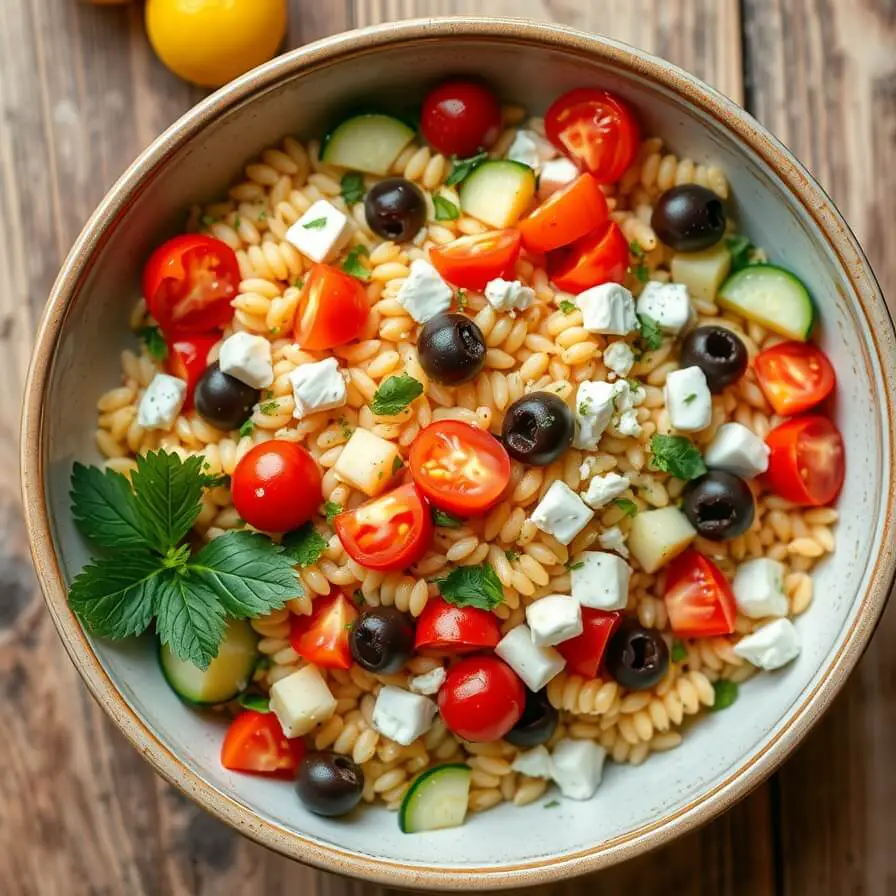Mediterranean Orzo Salad Recipe

When I first discovered this Mediterranean Orzo Salad, it felt like a little burst of sunshine on a plate. I remember one weekend when my family decided to have a casual backyard lunch. I wanted something light, fresh, and full of flavor—something that would balance perfectly with grilled chicken and crispy bread. I tossed together orzo, fresh vegetables, and a tangy lemon-olive oil dressing, not expecting much. But the first bite had everyone smiling, asking for seconds. There’s something magical about the simplicity of Mediterranean flavors—bright herbs, tangy feta, and juicy tomatoes—that makes every bite satisfying. It’s one of those recipes I always keep handy for a quick lunch, picnic, or potluck because it’s as versatile as it is delicious.
What I love most about this salad is how it brings people together. It’s light yet filling, refreshing yet hearty, and best of all, it’s a recipe that’s hard to mess up. Every time I make it, I tweak it slightly depending on what vegetables are in season, or which herbs I have on hand. It’s forgiving, colorful, and just plain happy food.
Why I Love This Recipe
Mediterranean Orzo Salad isn’t just a recipe; it’s a celebration of simple, fresh ingredients. Unlike heavier pasta salads drenched in mayo, this one feels bright and alive. The flavors are layered—tangy feta, sweet cherry tomatoes, crisp cucumbers, and the subtle punch of kalamata olives all come together with the gentle bite of al dente orzo.
What sets it apart is its flexibility. You can make it in advance for a quick lunch, take it to a picnic, or serve it as a side for dinner parties. I love that it’s a one-bowl wonder—you can prep the orzo, chop the vegetables, whisk the dressing, and mix everything together without any stress. Another thing I adore is how it’s visually stunning. The colors—red, green, purple, and white—make it look like a dish that belongs in a glossy food magazine, yet it’s something you can make in under 30 minutes.
For me, the real charm is in the balance of flavors. There’s no single ingredient that dominates, yet every bite is full of excitement. The lemon-olive oil dressing ties it all together, making the vegetables pop and the orzo feel light and tender. It’s not just a salad; it’s a little Mediterranean escape on your plate.
Ingredients for Mediterranean Orzo Salad
For this recipe, you don’t need anything fancy—just fresh, good-quality ingredients.
You’ll need orzo pasta as your base. I prefer a medium-grain orzo because it holds the dressing well and doesn’t get mushy. Cherry tomatoes add sweetness and a pop of color. Cucumbers bring a refreshing crunch, while red onions add a gentle bite. Kalamata olives are a must—they introduce that briny, salty flavor that pairs beautifully with the creamy feta cheese.
Feta cheese is essential here. Go for a block of good-quality feta rather than pre-crumbled; it has better texture and flavor. Fresh herbs like parsley and mint are my favorites—they make the salad smell incredible and lift every bite. For the dressing, all you need is extra-virgin olive oil, lemon juice, garlic, and a pinch of salt and pepper. Simple, but it makes the ingredients shine.
If you like, you can also add roasted red peppers for sweetness or artichoke hearts for extra texture. The beauty of this salad is that it’s endlessly adaptable. The ingredients are all easy to find, and you can make swaps depending on your pantry.
How Much Time Will You Need?
One of the best things about Mediterranean Orzo Salad is how quickly it comes together. You can have it ready in about 25 to 30 minutes from start to finish.
- Boiling the orzo takes around 8–10 minutes.
- Chopping the vegetables takes about 10 minutes if you’re efficient.
- Mixing the dressing and tossing everything together takes another 5 minutes.
If you want the flavors to meld even more, I like to make it an hour ahead of time and chill it in the fridge. That way, the orzo absorbs the dressing, and the vegetables taste even fresher.
How to Make This Mediterranean Orzo Salad

Step – 1: Cook the orzo according to package instructions. Make sure to salt the water lightly. You want the pasta al dente, so it keeps its shape and doesn’t get mushy. Once cooked, drain it and rinse briefly with cold water to stop the cooking. Let it cool slightly.
Step – 2: While the orzo is cooking, chop your vegetables. Halve the cherry tomatoes, dice the cucumber, thinly slice the red onion, and roughly chop fresh parsley and mint. If you’re using roasted red peppers or artichoke hearts, chop them into bite-sized pieces too.
Step – 3: Prepare the dressing. In a small bowl, whisk together 1/4 cup extra-virgin olive oil, the juice of one lemon, a minced garlic clove, and a pinch of salt and pepper. Taste and adjust seasoning as needed.
Step – 4: In a large mixing bowl, combine the cooked orzo, chopped vegetables, kalamata olives, and crumbled feta. Pour the dressing over the salad and toss gently to coat everything evenly.
Step – 5: Taste and adjust seasoning. Sometimes I like to add a little more lemon juice for brightness or a sprinkle of freshly ground black pepper for a subtle kick.
Step – 6: Let the salad rest for 10–15 minutes at room temperature or chill in the fridge for an hour. The flavors mingle beautifully, and the salad becomes even more delicious as it sits.
Substitutions
One of the joys of this recipe is its flexibility. Don’t have kalamata olives? Green olives work just as well. Can’t find feta? Goat cheese is a creamy, tangy alternative.
If you’re vegan, you can skip the cheese altogether or use a plant-based feta substitute. For the orzo, whole wheat orzo adds extra fiber, or you can even use quinoa for a gluten-free version. I’ve sometimes added sun-dried tomatoes for extra sweetness or pine nuts for a nutty crunch.
The key is to stick with ingredients that complement the Mediterranean flavors—bright, fresh, and balanced.
Best Side Dishes for Mediterranean Orzo Salad
This salad works beautifully as a main or a side. If you want to serve it as a side, I recommend pairing it with:
- Grilled lemon herb chicken for a protein boost.
- Roasted Mediterranean vegetables for a veggie-packed meal.
- Crispy pita bread with hummus for a fun, casual lunch.
Each of these sides complements the freshness of the salad while adding layers of flavor and texture to your meal.
Serving and Presentation Tips
When it comes to serving Mediterranean Orzo Salad, I love to make it feel as vibrant as it tastes. One of my favorite tricks is to serve it in a wide, shallow bowl so the colors pop—red cherry tomatoes, green herbs, deep purple olives, and white feta all create a feast for the eyes before the first bite.
Adding a few fresh herb sprigs on top right before serving gives it a professional touch. You can also drizzle a little extra olive oil or a squeeze of lemon over the top for a glossy, appetizing finish. If you’re hosting a casual lunch, individual glass bowls work beautifully, letting each guest see the vibrant layers.
For a picnic or potluck, I like to serve it chilled in a large, clear bowl with a serving spoon. It keeps the salad fresh while making it easy for everyone to help themselves. Presentation doesn’t need to be complicated—sometimes the simplest approach highlights the natural beauty of the ingredients best.
Tips and Tricks to Make This Recipe Even Better

There are a few little tips I’ve learned over the years that really elevate this salad.
First, always cook the orzo just until al dente. Overcooked orzo can become mushy and ruin the texture. Rinsing it briefly with cold water stops the cooking and keeps the grains separate.
Second, balance your flavors carefully. I like to taste as I go, especially when making the dressing. If the salad feels flat, a little extra lemon juice or a pinch of salt can make a huge difference.
Third, freshness matters. Use fresh herbs, ripe cherry tomatoes, and a good-quality feta. These simple details transform an ordinary salad into something special.
Finally, let the salad rest for at least 10–15 minutes after tossing. This allows the dressing to meld with the vegetables and pasta, making every bite flavorful and cohesive.
Common Mistakes to Avoid
Even simple recipes have pitfalls, and Mediterranean Orzo Salad is no exception.
A common mistake is overcooking the orzo. Mushy pasta can make the whole salad feel heavy and unappetizing. Keep an eye on it and drain promptly.
Another mistake is under-seasoning. Orzo absorbs the dressing, so be generous with salt, pepper, and lemon juice. Without proper seasoning, the flavors feel muted.
Using wilted or low-quality vegetables can also diminish the salad’s vibrancy. Always opt for fresh, crisp ingredients.
Lastly, don’t toss the salad too early if you plan to serve it later. While a short rest enhances flavor, leaving it overnight in the fridge can make it soggy. Mix gently when ready to serve.
How to Store It
Mediterranean Orzo Salad keeps well in the fridge, making it perfect for meal prep or leftovers. Store it in an airtight container for up to 3 days.
If you’re storing in advance, keep the feta separate until just before serving, if possible. This prevents it from becoming overly salty as it sits in the dressing.
When ready to eat, give it a gentle toss and, if needed, a squeeze of fresh lemon or drizzle of olive oil to refresh the flavors. This little step brings the salad back to life.
FAQ
Can I make this salad ahead of time?
Yes! It actually tastes better after the flavors have had time to meld. Just keep it in the fridge and add any delicate herbs or extra feta right before serving.
Is this salad gluten-free?
Traditional orzo is made from wheat, so it’s not gluten-free. You can substitute with gluten-free orzo or quinoa for a gluten-free version.
Can I add protein?
Absolutely. Grilled chicken, shrimp, or chickpeas are excellent additions if you want to make this a more substantial meal.
Can I use a different cheese?
Yes. While feta is traditional, goat cheese or a vegan cheese alternative works as well. Choose a cheese that complements the tangy, Mediterranean flavors.
What’s the best way to serve leftovers?
Store in an airtight container in the fridge for up to 3 days. Serve cold or at room temperature, tossing gently with extra lemon or olive oil if needed.

Mediterranean Orzo Salad Recipe
- Total Time: 25 minutes
- Yield: 4–6 1x
- Diet: Vegetarian
Description
Mediterranean Orzo Salad is a vibrant, fresh, and flavorful dish that brings the best of the Mediterranean to your plate. With al dente orzo, crisp cucumbers, juicy cherry tomatoes, briny olives, creamy feta, and a bright lemon-olive oil dressing, this salad is perfect for lunch, potlucks, or as a side for dinner. It’s quick to make, visually stunning, and endlessly adaptable. Whether you want a light meal or a colorful side dish, this salad hits all the right notes. The secret is fresh ingredients, balanced flavors, and a little love in every toss.
Ingredients
- 1 cup orzo pasta
- 1 cup cherry tomatoes, halved
- 1 cup cucumber, diced
- 1/2 cup red onion, thinly sliced
- 1/2 cup kalamata olives, pitted
- 1/2 cup feta cheese, crumbled
- 1/4 cup fresh parsley, chopped
- 2 tbsp fresh mint, chopped
- 1/4 cup extra-virgin olive oil
- Juice of 1 lemon
- 1 garlic clove, minced
- Salt and freshly ground black pepper to taste
Instructions
- Cook the orzo according to package directions, drain, and rinse with cold water.
- Chop the vegetables and herbs.
- Whisk together olive oil, lemon juice, garlic, salt, and pepper to make the dressing.
- In a large bowl, combine orzo, vegetables, olives, and feta. Pour dressing over and toss gently.
- Taste and adjust seasoning if needed. Let rest for 10–15 minutes before serving.
Notes
- Use fresh herbs for maximum flavor.
- For a vegan version, omit feta or use a plant-based alternative.
- The salad can be made a few hours in advance and stored in the fridge.
- Prep Time: 15 minutes
- Cook Time: 10 minutes
- Category: Salad
- Method: No-cook / Boiled pasta
- Cuisine: Mediterranean
Nutrition
- Serving Size: 4–6
- Calories: 240
- Sugar: 3g
- Sodium: 450mg
- Fat: 14g
- Saturated Fat: 4g
- Unsaturated Fat: 10g
- Trans Fat: 0g
- Carbohydrates: 25g
- Fiber: 3g
- Protein: 6g
- Cholesterol: 12mg







